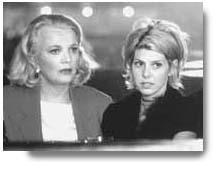"Bastard Out of Carolina": Anjelica Huston,
"Bastard Out of Carolina": Anjelica Huston,
U.S.A.
Today, 4:15 p.m.; Friday, 6:30 p.m.
"Bastard Out of Carolina," the film version of Dorothy Allison's critically acclaimed novel about growing up poor in South Carolina in the 1950s, is stirring up controversy because it contains brutally realistic scenes of child abuse.
Ted Turner financed the made-for-television movie and gave Anjelica Huston her first chance to direct. He screened the final result and dropped it like a hot potato. Reports are that his wife, Jane Fonda, screamed when she watched certain scenes. Which begs the question, what did he expect? Didn't anyone at Turner Television read the script, or the book? Because "Bastard" is a faithful rendition, down to the first-person voice-over narrative by Laura Dern.
It stars a relatively restrained Jennifer Jason Leigh as Anney Boatwright, mother of the bastard of the title. Anney's illegitimate first daughter is dubbed "Bone" by her Uncle Earl, who looks at the newborn and says, "She ain't no bigger than a knuckle bone."
Twelve-year-old Jena Malone is heartbreaking as Bone. The love between mother and daughter is wide as the screen, which makes Daddy Glen, the sadistic man who marries Anney and comes between them, a villain par excellence. Ron Eldard plays the weak man who takes out his frustrations on his stepchild.
But no, this is not gratuitous violence. It's how it is for too many children today. Directed by an actress who understands the power of emotion. Played by an ensemble of women who show on their faces how generations have endured poverty, abuse, and the struggle to find love. Glenne Headley and Diana Scarwid are strong as Bone's aunts, as is Grace Zabriskie as the matriarch of the family who can tell there's something wrong with Daddy Glen with just one look.

